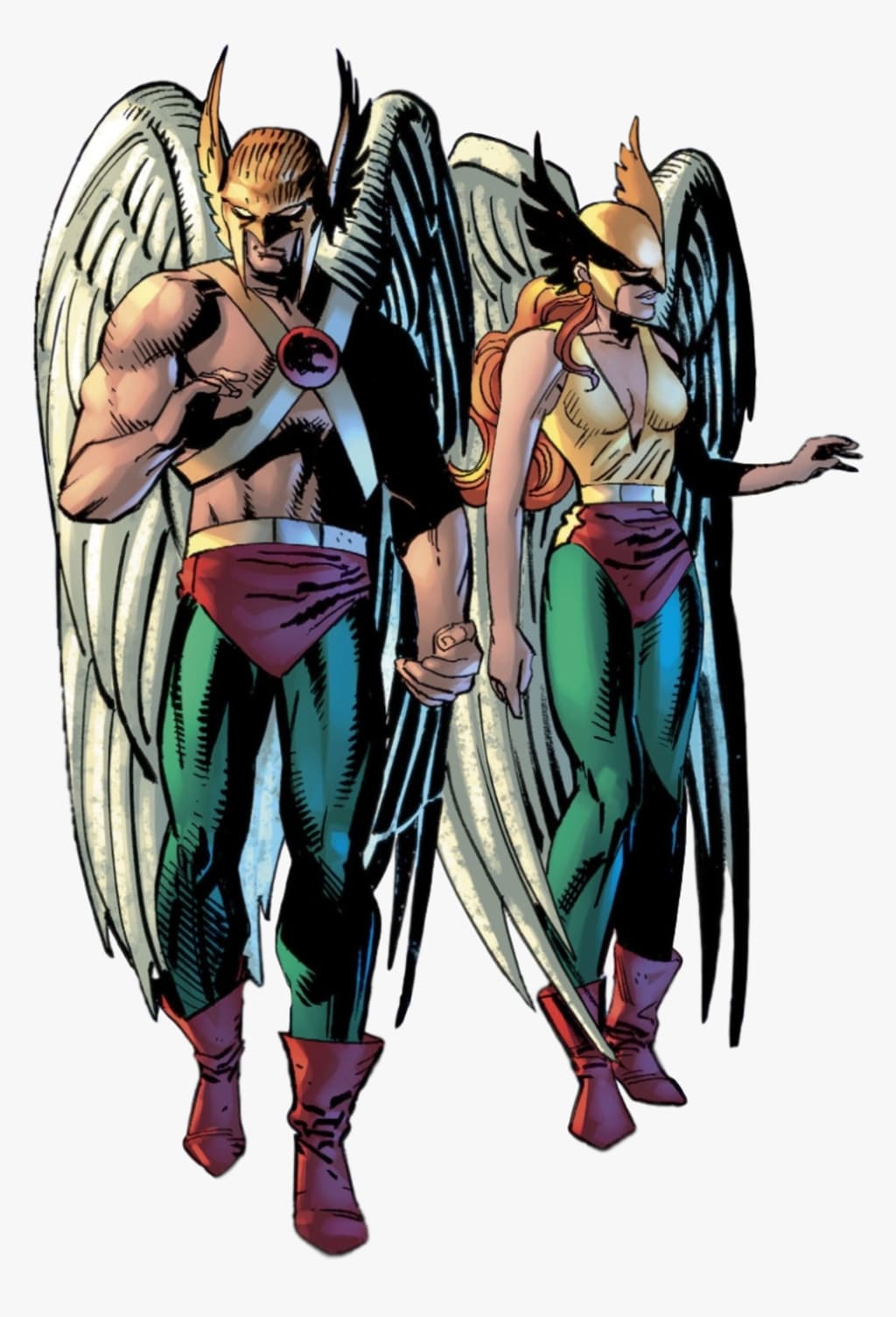
One of the great things about the characters in the DC Universe is their rich history. Many if not most of the classic characters have roots in the 1940s. Yet this is also a challenging thing for the characters, because times change. Unlike Marvel, which has a view that with some exception, events in the Marvel Universe have taken place over the past 10 to 15 years, regardless of what year this is, the DC Universe has tried to stay current, sort of. The historic characters and stories are recognized, as well as updated stories and characters, in an attempt to make everyone happy. To do this, they have restarted their universe multiple times, and each time they've had to address the question of, "What about Hawkman?"
One of the most visually interesting heroes, Hawkman started out as a basic concept, but as times changed, the character has been retooled, not always fitting with DC canon at the time. This has made for an interesting history in itself.
Golden Age

The original Hawkman first appeared in Flash Comics #1, in 1940. Hawkman's civilian identity was Carter Hall, an archeologist who discovered the Ninth (later Nth) Metal, a mysterious substance that had multiple properties, including defying gravity. He made the metal into a belt and wings to help him fly, then used weapons from the museum he curated to becoming a flying crime-fighter. Eventually it was revealed that Hall was also the reincarnation of the Egytptian prince Khufu. Hall fell in love with a young woman, Sheira Sanders, and revealed his secrets to her. He created a belt and wings for her similar to his own and she became his crimefighting partner, Hawkgirl. The two joined comics' first super-team, the Justice Society of America, and Hawkman became chairman. He was also the only character to appear in every adventure of the JSA.
As the 40s drew to a close, super-hero comics became less popular, and as with the rest of the characters except Superman, Batman, and Wonder Woman, DC stopped publishing new comics featuring Hawkman, until editor Julius Schwarz decided to revamp and revive them, which started what became The Silver Age of Comics.
Katar Hol of Thanagar

The new Hawkman and Hawkgirl were alien police from the planet Thanagar, who came to Earth in pursuit of a criminal. Intrigued by the people of Earth and already married, the pair adopted the identities of Carter and Shiera Hall and took jobs as museum curators, much like the Golden Age originals. This Hawkman and Hawkgirl also joined a super-team, this time the Justice League of America, where space-cop Hawkman often argued with much more liberal crime-fighter Green Arrow.
Infinite Earths
Eventually, DC had the original heroes meet their modern counterparts, establishing that they lived on parallel worlds. Earth 1 was the modern world with modern-day versions of the heroes while Earth 2 had the classic versions that fought in World War II. In some stories over the years, it was said that on Earth 2, the War was still going on.
Unlike the 1940s Hawkman, the 1960s Hawkman had his own series, which was eventually merged with that of the Atom, and then ultimately cancelled. Hawkman continued to appear in "Justice League of America", "World's Finest", and other titles throughout the 60s and 70s.
Crisis

In 1985, DC streamlined continuity with the landmark series "Crisis on Infinite Earths." Over the years multiple Earths had been established, with multiple versions of heroes, or sometimes different heroes DC had acquired from other companies, such as Earth-S, which had the Fawcett Comics "Shazam" characters. In the series, the other worlds are all collapsed into one world, one timeline, so the original heroes of the Golden Age were active in the 40s, and then largely retired, while the modern heroes were currently active, having started sometime in the past decade. For the first time, heroes were allowed to age normally, with teen sidekicks such as Robin growing to adulthood and taking on new identities.
But where did this leave Hawkman? With the original hero an Earth man and the modern one an alien, how can they be alive in the same world? Attempts were made to credit some stories to one, some to the other, with a bit of overlap, but it was a difficult fit. So a bigger change was needed.
Hawkworld

The mini-series "Hawkworld" went in the direction started by "The Dark Knight Returns" and "Green Arrow: The Longbow Hunters" and gave Hawkman a darker, edgier feel. Now Thanagar was a stratified, classist society in which the elite were literally elevated and the poor are literally low, on the ground. The Hawkmen are the police keeping order over it all.
With this series, and new continuity, Katar Hol only came to Earth recently, and Thanagar is where Nth Metal originated. All previous stories involving Hawkman and Hawkgirl were with the heroes of the 40s, still active off and on until the new heroes came about. This made the 1940s Hawks members of both the Justice League and Justice Society, an interesting but problematic concept.
DC tweaked continuity again with their "Zero Hour" event, which gave new origin stories for many of their characters and tried to make the books more approachable for new readers. Despite this, Hawkman's regular title petered out and was cancelled, and Hawkman didn't appear in any DC Comics for some time because he was deemed to be "too complicated."
Zauriel
During this time without a Hawkman, Grant Morrison took over a new Justice League title, "JLA," in which he wanted there to be all the heroes who made Justice League great in the past, but DC was not allowing use of Hawkman. So, Morrison introduced a new character, Zauriel the archangel. An actual archangel from Heaven, Zauriel helps the team on a mission and joins them, but doesn't last long. The character was never very popular and Morrison was frustrated by limitations on the use of the Hawkman name.
One hero, reincarnated many times
In the 1990s the title "JSA" reintroduced Hawkman with a clarified backstory that embraced past and modern versions of the hero. Hearkening back to his original appearances, in which it was said Carter Hall was the reincarnation of Egyptian prince Khufu, it was explained that both Khufu and his princess had died and been reincarnated many times over the centuries. The 1940s heroes were one incarnation, and the heroes from Hawkworld in the 90s were another. Same soul, different bodies.
This launched Hawkman and Hawkgirl into a new series, and had a new question behind it: "Do two entwined souls always have to share the same destiny?" Just because Hawkman and Hawkgirl had always been lovers or married in every other incarnation, did they have to be in this one?
What made the question more interesting was that the new incarnation of Carter Hall was older than the new Shiera Hall, who was supposed to be about 19. He wanted to embrace their traditional destiny and continue on as partners in battle and in life, but Hawkgirl wasn't so sure. This came to a head and was decided as the title changed with issue 50 and there was for the first time a "Hawkgirl" series. It was around this time that Hawkgirl joined the Justice League on her own, and appeared in the new Justice League cartoon, in a main role, without Hawkman.
The Savage Hawkman

DC rebooted its universe again, creating a "New 52", where there are 52 worlds, including an Earth 2 with the Justice Society. This gave a fresh start to all titles including Justice League, where Hawkman isn't a member of the main, accepted team, but an offshoot team. He is still alien from Thanagar Katar Hol, but uses the name Carter Hall as an alias. Featuring a grittier attitude and more violence, this depiction of Hawkman was similar to previous ones. but a bit more modern.
Overall, it may be that Hawkman's greatest strength is his visual appeal. He has always looked cool. But his weakness isn't his history, but what you can do with him. While his abilities have varied over the years, primarily he's a guy who flies. People have always wanted to fly, and flying is useful when you're trying to catch a thief. But when you're battling super-villains, especially the major ones, even if you're a guy who flies and carries a spear, a mace, a sword, what really can you do? Angel from Marvel's X-Men had the same problem. Being a scout or rescuing people from a burning building is great, but against Magneto or the Blob, good luck. In Angel's case he got a serious power upgrade and became Archangel. With Hawkman, there have been periodic additions to his powers that have made him a bit more formidable. At one time it was said the Nth metal gave him enhanced senses, and in each incarnation he is said to have enhanced strength ("the strength of 12 men!") but more recently it has been said that the metal greatly enhances his healing, making Hawkman more of a flying Wolverine, which is fitting given that former Marvel artist Rob Liefeld was on the most recent book.
About the Creator
Gene Lass
Gene Lass is a professional writer, writing and editing numerous books of non-fiction, poetry, and fiction. Several have been Top 100 Amazon Best Sellers. His short story, “Fence Sitter” was nominated for Best of the Net 2020.






Comments
There are no comments for this story
Be the first to respond and start the conversation.